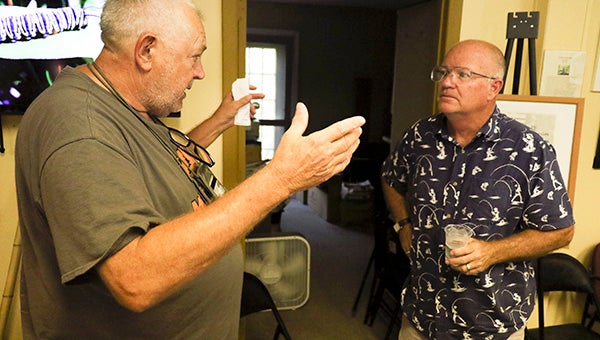Butterfly way stations
Published 7:00 am Tuesday, September 6, 2016

CONTINUED DISCUSSION: Gregory Nordstrom, at right, speaks with attendees of the Crosby Arboretum after his presentation on monarch butterflies. Nordstrom has a milkweed garden at his home to attract the species as they migrate from Canada to Mexico.
Photo by Jeremy Pittari
They flutter in on a wave of black and gold, looking for one particular host plant that will serve as a meal for their progeny and, subsequently, their breeding ground.
Every butterfly has their own host plant. Milkweed is the monarch’s, making it the only food source for the caterpillar of the species, said Gregory Nordstrom. He is a hobbyist, assisting in the creation of breeding grounds in his Biloxi yard that serve as a way station. He has registered his yard with the University of Kansas in Lawrence’s Monarch Watch program, which entails a number of other way stations across the country.
Saturday he gave a presentation at the Crosby Arboretum that included footage he’s captured in his yard as he provides a sanctuary for them to breed and continue on their path to Mexico. The photograph and video footage he’s captured of the various life cycles of the monarch were also shown during his presentation.
These gardens are important for the monarch, since they don’t live long enough to get where they are heading, they have to stop along the way to lay eggs for the next generation. Most of the monarchs Mississippi residents see are on their way to Mexico from Canada, traveling along the East Coast. The trek takes about three months.
While the generation that travels there and back only live about a month or two, the generation that makes it to Mexico can live up to four months, Nordstrom said. It’s unknown why one generation lives longer than another, he said.
Their life as a caterpillar lasts about two weeks, before they perch themselves upside down in the form of a “j”, and shed their caterpillar skin to enter the chrysalis stage. That stage lasts about 10 days in ideal weather, but in colder climates can last as long as a month.
With a 95 percent mortality rate, the success of the monarch relies on large numbers. Nordstrom said one female can lay about 400 eggs, laying one at a time on low lying leaves of the milkweed. They are cream colored at first, but just before they hatch a black spot appears at the top, which is the head of the caterpillar. Since they are poisonous to birds, the major predators to the monarch caterpillar are wasps and a type of fly that lays eggs in them, which don’t hatch until the caterpillar enters the chrysalis stage.
When the caterpillars hatch, they eat their way out of the egg, then turn around and finish their first meal, the rest of the egg.
Aside from covering the life cycle of this, and essentially every butterfly, Nordstrom also gave the attendees a tip on identifying the difference between the male and female of the species. Males, he said, have two black spots on the bottom of their wings near the base of the abdomen; while females have larger more pronounced veins in their wings.
The Arboretum is currently housing a gallery exhibit of Nordstrom’s art of the butterfly until November 30.




